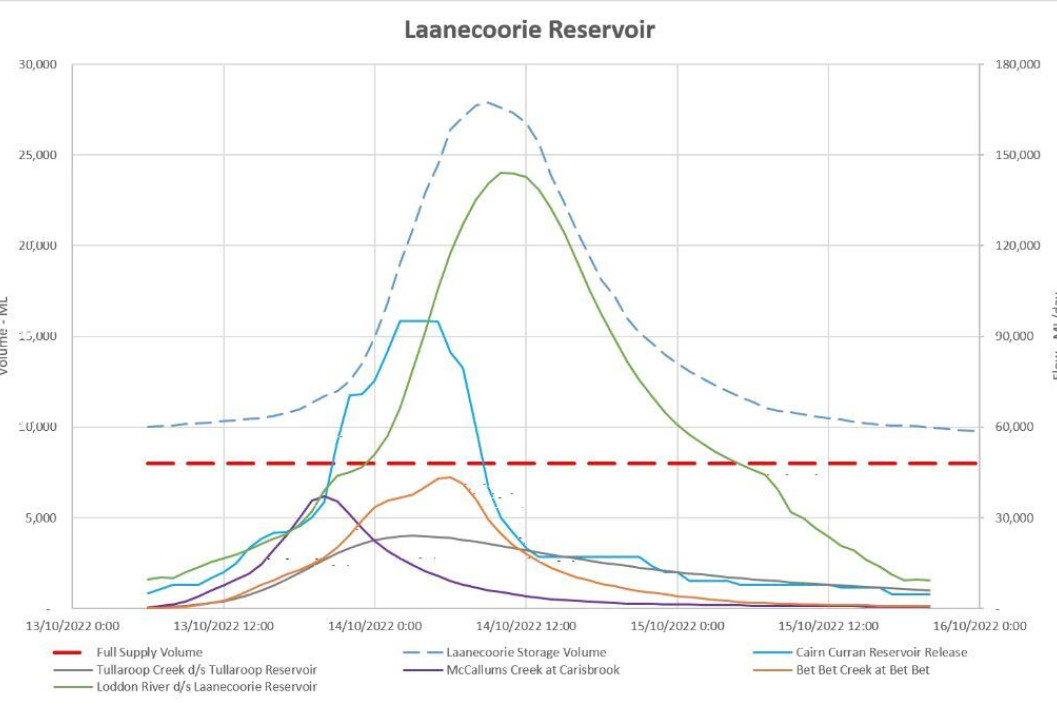General News
22 January, 2023
Anatomy of flood overflow
MAJOR reservoirs flowing into the Loddon River were not specifically for flood mitigation, according to Goulburn Murray Water. In a post-October flood emergency mapping report, the water authority said Laanecoorie, Cairn Curran and Tullaroop...

MAJOR reservoirs flowing into the Loddon River were not specifically for flood mitigation, according to Goulburn Murray Water.
In a post-October flood emergency mapping report, the water authority said Laanecoorie, Cairn Curran and Tullaroop Reservoirs were “designed and operated to provide a secure and safe water supply”.
“If there is opportunity, the storages can be operated to reduce the downstream flood peak where possible,” the report said.
GMW was criticised by some Newbridge community leaders after near-record floods again sent the town’s recreation reserve under water as the Loddon River started to unleash its fury on downstream towns from October 14.
Ron Trimble said as the town’s clean-up started that he had questions, about the water management at Cairn Curran that sent massive inflows towards Laanecoorie Reservoir.
“Cairn Curran was built for flood mitigation. During the drought years it was at a low level and irrigators around here had a zero allocation,” he said.
“I don’t understand, however, the rationale of keeping it at a high level when there is a La Nina. That needs to be explained and a lot of farmers are asking the same thing.
“They (GMW) had plenty of warning there was a La Nina and a buffer would have taken a bit out of here and south,” he said.
But releasing its Floods in Focus mapping three days before Christmas, GMW said: “Water storages may provide significant mitigation for small floods and may reduce downstream flooding. However, a storage’s ability to mitigate downstream flows so they remain below flood thresholds reduces as floods become larger.”
Analysing the build up to October’s floods, GMW said: “In September the Bureau of Meteorology declared a La Niña weather pattern for a third consecutive year – increasing the chances of above-average rainfall across the GMW region. This was only the third time an extended La Niña has occurred since records began in 1900.
“Victoria’s weather this year (2022) has also been influenced by a negative Indian Ocean Dipole, which typically sees above-average winter-spring rainfall in Australia.
“The weather patterns we have received have caused a wetter catchment, higher soil moisture content, and minimal water absorption, leading to increased runoff and higher river levels.”
“Cairn Curran Reservoir initially reached full supply level following a moderate rainfall and subsequent inflow event on October 7 and 8. GMW initiated a pre-release of water from Cairn Curran following this event at a rate of approximately 5000 ML a day to create space in the storage. This created approximately 16,350 ML of space prior to the major rainfall event on October 13 and 14.
“Inflows to Cairn Curran peaked at 116,000 ML a day on October 14. Releases from Cairn Curran peaked at 95,000 ML a day. Pre-releases before and during the rain event allowed the downstream flow to be reduced by approximately 21,000 ML a day. Total inflows over the 24-hour period from 1pm on October 13 were around 67,000 ML, which is around 45 per cent of the total storage capacity.
“On October 13 flows from the Bet Bet and McCallums creeks as well as Tullaroop and Cairn Curran reservoirs arrived at Laanecoorie.
“The flow downstream of Laanecoorie Reservoir peaked at about 145,000 ML a day on October 14, about three metres above the major flood level.”
The report said river flows in the Loddon system rose and fell quickly in response to heavy rain.
“By October 17 the level downstream of Laanecoorie Reservoir was below moderate flood level. Once downstream of Laanecoorie Reservoir, flows dispersed across the floodplain and have been slowly moving north towards the Murray River.”